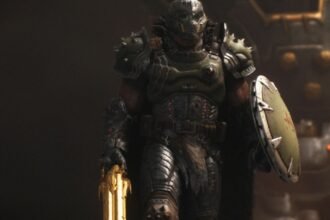In 2019, director Tim Miller, known for his work on Deadpool and Terminator: Dark Fate, premiered Love, Death & Robots, an animated anthology series on Netflix. This series acts as a platform for Miller’s Blur Studio, showcasing a variety of animated shorts created by different animators. Each season has garnered critical acclaim, winning a Primetime Emmy and containing a diverse range of stories across genres like horror, sci-fi, and fantasy, with episodes lasting between six to twenty minutes.
Miller employed a similar approach in Prime Video’s Secret Level, which features shorts inspired by various video games. However, he returned to Love, Death & Robots with a new ten-episode season that, while the longest to date, is regarded as one of the weaker installments.
The strength of an episode in Love, Death & Robots often hinges on its originality or humor. John Scalzi is a favored contributor, delivering two episodes in volume 4 with mixed outcomes. Unfortunately, this season suffers from an overreliance on visuals over substance, as certain episodes offer stunning animations yet lack compelling plots. Others stray too far from established genres or the animation format itself. The anthology structure allows viewers to quickly move past any lackluster episodes, but volume 4 includes several disappointments.
The series shines when it crafts tight narratives that deliver strange and often unsettling tales. Highlights include Peter F. Hamilton’s dark twist on Pokémon battles in “Sonnie’s Edge” and Neal Asher’s maritime horror in “Bad Traveling,” which was expertly directed by David Fincher and featured a chilling performance by Troy Baker. Thankfully, one episode in volume 4 continues this trend.
“How Zeke Got Religion,” penned by J.T. Petty based on a short story by John McNichol, blends elements from Masters of the Air and Hellboy. Like the standout episode from last season, “In Vaulted Halls Entombed,” this one begins as a war narrative before transitioning into pure horror.
In this episode, the crew of the B-17 Flying Fortress named Liberty Belle feels uneasy after being treated to chocolate and a John Wayne film, suspecting that “when brass is nice, it’s time to worry.” Tasked with a solo bombing mission against a church in France, under enigmatic orders from a new commander, the crew shows off their teamwork while facing flak, misfiring weapons, and a brutal dogfight—elements that would typically characterize most missions. However, the church holds secrets as the site of a grisly Nazi ritual aimed at summoning a fallen archangel, which then pursues their aircraft, resulting in a dramatic genre shift and a gruesome showdown that prompts protagonist Zeke to reassess his understanding of the world.
Director Diego Porral, who previously led the animation for last season’s intense “Kill Team Kill,” collaborates adeptly with Titmouse, the studio behind Scavengers Reign and Pantheon, to create a visually striking angel far removed from traditional depictions—sporting a cherubic face and an unsettling number of eyes, it tears soldiers apart using tiny hands. When it grotesquely spits bullets from new mouths, the crew learns that faith is their ultimate weapon.
If you watch just one episode from volume 4 of Love, Death & Robots, make it “How Zeke Got Religion.” Afterward, you can refer to the ranked list of the season’s other entries.
Another episode stands out as a less impactful entry: a music video for the Red Hot Chili Peppers, shot by David Fincher with marionettes as stand-ins for the band and audience. Lacking the series’ hallmark themes of love, death, or robots, it feels somewhat superfluous.
9. “The Screaming of the Tyrannosaur”
In this episode, MrBeast takes on the role of an emcee in a spectacle filled with triceratops, a tyrannosaurus, and over-the-top voiceovers. However, the predictability and self-seriousness detract from the potential fun of dinosaur battles.
The series revisits Bruce Sterling’s universe introduced in season 3 with “Swarm,” but this time with a less engaging story. Whereas “Swarm” tackled profound themes of human greed and sentience, this episode settles for a lackluster revenge narrative featuring an odd, adorable alien pet. Nevertheless, the animation of astronauts floating in space remains visually stunning.
Rhys Darby (from What We Do in the Shadows and Our Flag Means Death) portrays a vicar captivated by a dolphin’s resurrection, which draws the attention of aquatic aliens. Unfortunately, the episode lacks depth, and it feels odd to include a live-action short among the animated ones.
6. “The Other Large Thing”
This episode, the lesser of two stories adapted from Scalzi’s works, revolves around a fluffy cat named Sanchez (voiced by Chris Parnell) who sees an opportunity for domination when his apat









